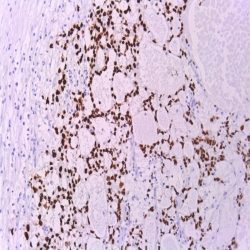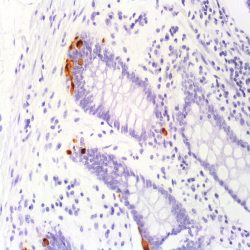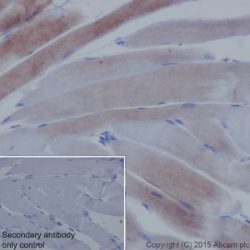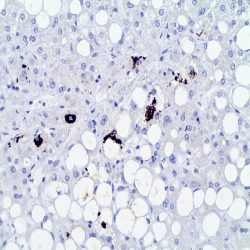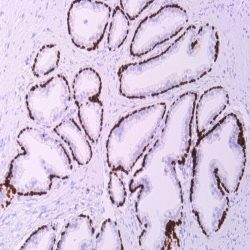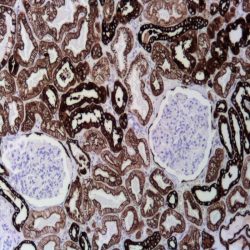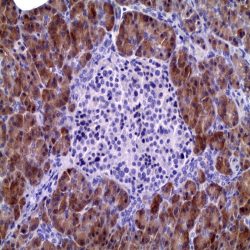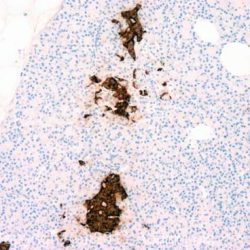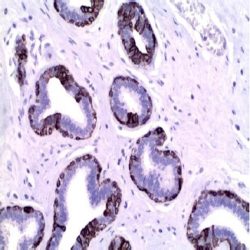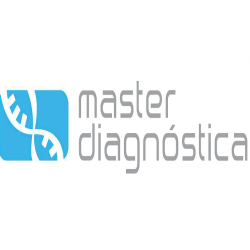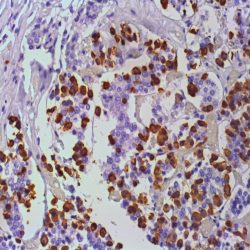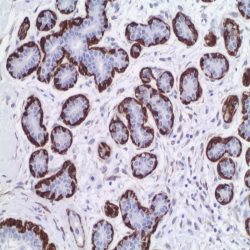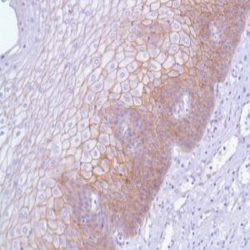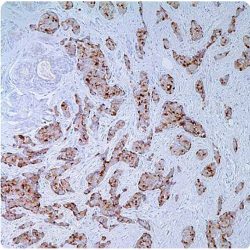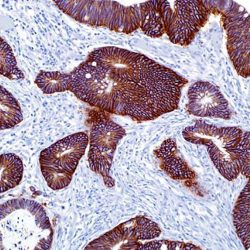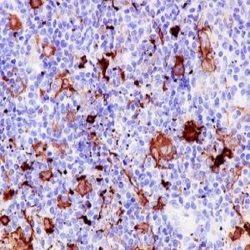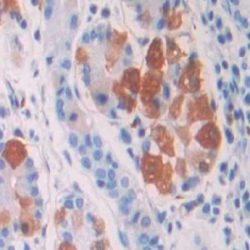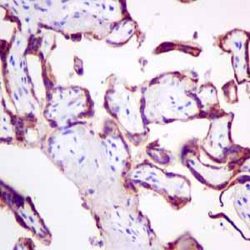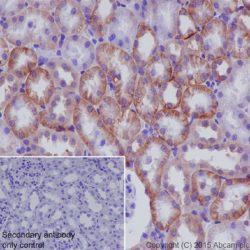Category: immunohistochemistry
Showing 221–240 of 391 results
فیلتر ها-
آنتی بادیهای ایمونوهیستوشیمی
آنتی بادی SALL4 (EE-30)
Rated 0 out of 5Name: Antibody SALL4 clone EE-30
Description and aplications: Sall3 (SALL3, sal-like 3) and Sall4 (SALL4, sal-like 4) are mammalian homologs of the Drosophila region-specific homeotic gene spalt, which encodes a zinc fingercontaining transcription regulator. Drosophila spalt is an essential genetic component required for the specification of posterior head and anterior tail as opposed to trunk. Sall3 is expressed at 24 weeks of gestation in several regions of the human fetal brain including neurons of the hippocampus formation and of mediodorsal and ventrolateral thalamic nuclei, Purkinje cells of the cerebellum and a subset of neurons in the brainstem. Sall4 expression in early mouse embryos is gradually confined to the head region and the primitive streak, followed by prominent expression in the developing midbrain, branchial arches, limbs and genital papilla. SALL4 has been considered as a pan-marker for germ cell tumors. However, positivity might occur in undifferentiated neoplasm of digestive or urogenital system.
Composition: anti-human SALL4 mouse monoclonal antibody prepared in 10mM PBS, pH 7.4, with 0.2% BSA and 0.09% sodium azide
-
آنتی بادیهای ایمونوهیستوشیمی
آنتی بادی Serotonin (5HT-H209)
Rated 0 out of 5Name:Antibody Serotonin clone 5HT-H209
Description and applications: Serotonin-positive cells are present in gastric, duodenal, jejunal, ileal, colonic, and appendiceal mucosae. Positive cells are sparse and usually occur in the lower half of the gastric and intestinal mucosae. In the appendix, in addition to the mucosal serotonincontaining cells, there are single or small clusters of serotoninpositive cells in the sub-epithelial region of the lamina propria.
Composition: Anti-human Serotonin mouse monoclonal antibody purified from serum and prepared in 10mM PBS, pH 7.4, with 0.2% BSA and 0.09% sodium azide
-
آنتی بادیهای ایمونوهیستوشیمی
آنتی بادی Skeletal Muscle Actin (5C5,F8,C7)
Rated 0 out of 5Name:Antibody Skeletal Muscle Actin clone 5C5,F8,C7
Description and applications: 5C5.F8.C7 MAb is highly specific and shows no crossreaction with smooth muscle actin. This antibody reacts with sarcomeric actins of normal tissues and neoplasms derived from such tissues (i.e. rhabdomyosarcomas).
Composition: Anti-human Skeletal Muscle Actin mouse monoclonal antibody purified from serum and prepared in 10mM PBS, pH 7.4, with 0.2% BSA and 0.09% sodium azide
-
آنتی بادیهای ایمونوهیستوشیمی
آنتی بادی P62 (3/P62 LCK LIGAND)
Rated 0 out of 5Name: P62 Antibody clone LCK LIGAND 3/P62
Description and applications: This antibody recognises phosphotyrosine p62, a member of the c-src family of cytoplasmic kinases, which binds as a ligand to the SH2 domains of p56 (Lcr) in the absence of phosphotyrosine. p62/SQSTM1 is an adapter protein targeting the protein aggregates ubiquitinated by lysosomal degradation. p62/SQSTM1 is selectively degraded via the autophagic pathway. Mallory’s hyaline and intracellular hyaline bodies are associated with chronic non-neoplastic liver diseases (steatohepatitis, related or not to alcohol abuse; toxic or metabolic chronic cholestasis) and with neoplastic liver diseases such as hepatocellular carcinoma. These inclusions are related to and contain keratin aggregates, especially keratin 8, ubiquitin, heat shock proteins, and the stress adaptor protein p62, stabilized by bonds catalysed by transglutaminases. P62 binds to ubiquitin and acts as an adaptor to bind ubiquitinated proteins. Autophagy is an evolutionary highly conserved degradative mechanism affecting the components of the cytoplasm that contributes to homoeostasis by making organelle replacement possible. Unlike the ubiquitin-proteosome system, the autophagy mechanism occurs in multiple steps that include the formation of the phagophore, which traps proteins and organelles for its degradation, and the autophagosome, which, through mechanisms involving cytoskeleton’s microtubules, fuses with lysosomes to form autolysosomes, where the material is eventually degraded. This antibody is useful for the identification of p62, found in Mallory’s hyaline and intracellular hyaline bodies present in chronic liver diseases and hepatocellular carcinomas. It is also useful to detect p62 in autophagic vacuoles present in various neurodegenerative, neoplastic infectious, and inflammatory neuromuscular diseases.
Composition: Anti-human P62 mouse monoclonal antibody purified from serum and prepared in 10mM PBS, pH 7.4, with 0.2% BSA and 0.09% sodium azide
-
آنتی بادیهای ایمونوهیستوشیمی
آنتی بادی p63 (4A4)
Rated 0 out of 5Name: Mouse anti-human p63 Monoclonal Antibody clone 4A4
Description and aplications: p63, a homolog of the tumor suppressor p53, has been identified in basal cells in the epithelial layers of a variety of tissues, including epidermis, cervix, urothelium, breast and prostate. p63 was detected in nuclei of the basal epithelium in normal prostate glands; however, it was not expressed in malignant tumors of the prostate. As a result, p63 has been reported as a useful marker for differentiating benign from malignant lesions in the prostate, particularly when used in combination with markers of high molecular weight cytokeratins and the prostate-specific marker AMACR (P504S). p63 has also been shown to be a sensitive marker for lung squamous cell carcinomas (SqCC), with reported sensitivities of 80-100%. Specificity for lung SqCC, vs. lung adenocarcinoma, has been reported to be approximately 70-90%, as positive staining with p63 has been typically observed in 10-30% of lung adenocarcinomas cases. In breast tissue, p63 has been identified in myoepithelial cells of normal ducts. Reports have described the utility of p63 in a panel of IHC markers for the assessment of breast lesions, due to the differential expression of the luminal vs. basal and myoepithelial markers.
Composition: anti-human p63 mouse monoclonal antibody purified from ascites. Prepared in 10mM PBS, pH 7.4, with 0.2% BSA and 0.09% sodium azide
-
آنتی بادیهای ایمونوهیستوشیمی
آنتی بادی Pan Melanoma Cocktail (HMB45+M2-7C10+M2-9E3)
Rated 0 out of 5Name: Pan Melanoma Cocktail Antibody clone HMB45+M2-7C10+M2-9E3
Description and applications: The antibody represents a cocktail of anti-gp100 (HMB45) and MART-1 antibodies. By
immunohistochemistry, it recognizes melanocytes and melanomas. This cocktail reacts with junctional and blue nevus cells and with fetal and neonatal melanocytes. It does not stain tumor cells of epithelial, lymphoid, glial, or mesenchymal origin. The antibody labels melanotic as well as amelanotic variants of melanomas. It is extremely sensitive for labeling formalin-fixed, paraffinembedded melanomas and other tumors showing melanocytic differentiation.Composition: Anti-human Pan Melanoma Cocktail mouse monoclonal antibody purified from serum and prepared in 10mM PBS, pH 7.4, with 0.2% BSA and 0.09% sodium azide
-
آنتی بادیهای ایمونوهیستوشیمی
آنتی بادی Pancreatic lipase (EPR6275)
Rated 0 out of 5Name: Pancreatic lipase Antibody clone EPR6275
Description and applications: Pancreatic lipase is a 56kDa molecular mass enzyme actively secreted in the duodenum by the pancreas in the presence of bile salts and colipase. It belongs to the family of triglyceride lipases, of which there are at least three tissue-specific isoenzymes (pancreatic, hepatic and gastric and lingual) that break down dietary fats by converting triglycerides into monoglycerides and free fatty acids. Pancreatic lipase together with bile salts favors the absorption into the lymphatic system of the monomers resulting from digestion. Human pancreatic lipase is encoded by the PNLIP gene of 13 exons and more than 20 kb, located on the chromosomal region 10q25.3. In normal tissues this antibody identifies pancreatic acinar cells and in neoplasms it recognizes acinary cell carcinoma of the pancreas, which expresses this marker in more than 50% of cases. For this reason and integrated in a panel of suitable antibodies, pancreatic lipase allows the differentiation of acinar adenocarcinoma of pancreas from other malignancies with similar morphology (especially neuroendocrine carcinoma with acinary architecture) and establish the pancreatic origin of distant metastases, that on numerous occasions may be the first manifestation of the tumor.
Composition: Anti-human Pancreatic lipase mouse monoclonal antibody purified from serum and prepared in 10mM PBS, pH 7.4, with 0.2% BSA and 0.09% sodium azide
-
آنتی بادیهای ایمونوهیستوشیمی
آنتی بادی Pancreatic Polypeptide (Polyclonal)
Rated 0 out of 5Name:Pancreatic Polypeptide Antibody
Description and applications: This gene belongs to the NPY family and it encodes a protein that is synthesized as a 95 aa polypeptide precursor in the pancreatic islets of Langerhans. It is cleaved into two peptide products; the active hormone of 36 aa and an icosapeptide of unknown function. The hormone acts as a regulator of pancreatic and gastrointestinal functions and may be important in the regulation of food intake. Plasma level of this hormone has been shown to be reduced in conditions associated with increased food intake and elevated in anorexia nervosa. In addition, infusion of this hormone in obese rodents has shown to decrease weight gain.
Composition: anti-human Pancreatic Polypeptide goat polyclonal antibody purified from serum and prepared in 10mM PBS, pH 7.4, with 0.2% BSA and 0.09% sodium azide
Immunogen: Synthetic peptide sequence (TRPRYGKRHKEDT) corresponding to the internal amino acids of PPY
-
آنتی بادیهای ایمونوهیستوشیمی
آنتی بادی Cytokeratin 14 (LL002)
Rated 0 out of 5Name: Cytokeratin 14 antibody clone LL002
Description and aplications: Cytokeratin 14 belongs to the type A (acidic) subfamily of low molecular weight keratins and exists in combination with keratin 5. Cytokeratin 14 has been studied as a prognostic marker in breast cancer. Here it is used as a marker for the myoepithelial cells and for the identification of basaloid histotype of breast carcinoma.
The antibody also distinguishes stratified epithelial cells from simple epithelial cells and has been reported useful in the identification of squamous cell carcinomas.Composition: anti-human Cytokeratin 14 mouse monoclonal antibody purified from ascites fluid by Protein G chromatography. Prepared in 10mM PBS, pH 7.4, with 0.2% BSA and 0.09% sodium azide
Immunogen: A synthetic peptide of 15 amino acid residues from the C-terminus of human keratin 14.
-
آنتی بادیهای ایمونوهیستوشیمی
آنتی بادی Cytokeratin 5/6/8/18 (EP24/EP67/B22.1&B23.1)
Rated 0 out of 5Name:Cytokeratin Antibody clone EP24/EP67/B22.1&B23.1
Description and applications: This antibody recognises cytokeratins 5, 6, 8, and 18. Proteins generically called intermediate filaments, because they measure between 7 and 22 nm in diameter (i.e., with a size between actin, 5-7 nm, and tubulin, 22-25 nm), are part, along with actin and tubulin, of the vertebrate cytoskeleton. This superfamily is composed of six subfamilies of molecules with different tissue expression patterns. Cytokeratins constitute homology groups I and II, and in humans they are encoded by more than 49 different genes located in chromosomes 17 (I) and 12 (II). The nomenclature chosen in 1982 by Moll and Franke assigns numbers from 1 to 8 to type II cytokeratins (neutral or basic) and from 9 to 21 to type I cytokeratins (acidic). An analogous nomenclature for hair keratins has now been defined, with the addition of letters Ha and Hb to distinguish type I from type II. Structurally, cytokeratins share with the rest of intermediate filaments a central axis of 310 amino acid residues consisting of four highly preserved α-helical domains (1A, 1B, 2A, and 2B) that define the type of intermediate filament that will be formed after assembly; these domains are separated by three non-helical linking regions (L1, L12, and L2) and two end domains which are highly different in size and sequence (head, 1, and tail, 2), each with constant (E1/E2), variable (V1/V2), and homology (H1/H2) regions, the latter characteristic of type II keratins and absent in type I keratins. The major immunogenic properties and the main differences between each keratin class are found in the variable domains. Keratins are usually assembled into I/II heterodimers and are specifically co-expressed in pairs in each tissue. Due to the high homology among the different molecules, it is common for a monoclonal antibody to react with different types of cytokeratins; for example, anti-cytokeratin AE1 labels cytokeratins 10, 14, 15, 16, and 19. The anti-cytokeratin monoclonal antibody cocktail is a broad-spectrum antibodt for general use. This antibody mixture reacts with carcinomas in general, but as with other anti-cytokeratin antibodies, it is possible that poorly differentiated carcinomas occasionally exhibit poor immunostaining. Its most common application is the differential diagnosis of malignant tumours, in which case it can be used within a panel of antibodies, such as anti-ALC, which recognises lymphoma, or anti-S100 or HMB45, which labels malignant melanoma. The staining of other non-carcinoma tumours is uncommon, although as with other anti-cytokeratin 8 antibodies, smooth muscle and leiomyoma labelling may occasionally be observed.
Composition: Anti-human Cytokeratin 5/6/8/18 rabbit/mouse monoclonal antibody purified from serum and prepared in 10mM PBS, pH 7.4, with 0.2% BSA and 0.09% sodium azide
-
آنتی بادیهای ایمونوهیستوشیمی
آنتی بادی ACTH (Adrenocorticotropic Hormone) (Polyclonal)
Rated 0 out of 5Name: Rabbit anti-human ACTH (Adrenocorticotrophic Hormone) Polyclonal Antibody
Description and applications: Anti-ACTH is a useful marker in classification of pituitary tumors and the study of pituitary disease. It reacts with ACTH-producing cells (corticotrophs). It also may react with other tumors (e.g., some small cell carcinomas of the lung) causing paraneoplastic syndromes by secreting ACTH.
Composition: anti-human ACTH rabbit monoclonal antibody purified from serum and prepared in 10mM PBS, pH 7.4, with 0.2% BSA and 0.09% sodium azide
Intended use : Immunohistochemistry (IHC) on paraffin embedded tissues. Not tested on frozen tissues or Western-Blotting
Immunogen: Synthetic peptide derived from Nterminus of human ACTH.
-
آنتی بادیهای ایمونوهیستوشیمی
آنتی بادی Calponin (EP63)
Rated 0 out of 5Name:Antibody Calponin clone EP63
Description and applications: Calponin is a smooth muscle specific, actin-, tropomyosin- and calmodulin-binding protein thought to be involved in regulation of actomyosin as well as the regulation or modulation of contraction. It is expressed on smooth muscle cells and myoepithelial cells. Calponin antibody has been used to identify invasion of breast lesion. Additionally, Calponin is expressed on malignant fibrous histiocytoma of bone and adenoid cystic carcinoma of salivary gland. The consistently positive staining pattern in adenoid cystic carcinomas may be useful in discriminating
Composition: Anti-human Calponin rabbit monoclonal antibody purified from serum and prepared in 10mM PBS, pH 7.4, with 0.2% BSA and 0.09% sodium azide
-
آنتی بادیهای ایمونوهیستوشیمی
آنتی بادی Delta Catenin-1 (p120) (EP66)
Rated 0 out of 5Name: Delta Catenin-1 (p120) (Clone EP66)
Description and applications:Catenins are proteins that are linked to the cytoplasmic domain of transmembrane cadherins. p120 Catenin is a member of this Armadillo gene family of junctional plaque proteins. The association of catenins to cadherins produces a complex which is linked to the actin filament network, and which seems to be important for cadherins cell-adhesion properties. Cytoplasmic accumulation of p120 Catenin has been observed in lung cancer, pancreatic cancer, gastric cancer and colon cancers and is associated with poor progress in colon cancer patients. In breast lobular neoplasia, anti p120 Catenin shows a diffuse cytoplasmic immunostaining pattern, while breast ductal neoplasia retains the membrane immunostaining pattern. p120 Catenin antibody is useful in differentiation of lobular carcinoma from ductal carcinoma of the breast and in identifying early lesions of lobular neoplasia.
Composition:Anti-human Delta Catenin-1 (p120) rabbit monoclonal antibody purified from serum and prepared in 10mM PBS, pH 7.4, with 0.2% BSA and 0.09% sodium azide.
Immunogen: A synthetic peptide corresponding to residues in human p120 Catenin protein.
-
آنتی بادیهای ایمونوهیستوشیمی
آنتی بادی Epithelial Membrane Antigen (EMA) (E29)
Rated 0 out of 5Name: Epithelial Membrane Antigen(EMA)-CloneE29
Description and applications: Anti-EMA antibody is a useful marker for staining many carcinomas. It stains normal and neoplastic cells from various tissues, including mammary epithelium, sweat glands and squamous epithelium. Hepatocellular carcinoma, adrenal carcinoma and embryonal carcinomas are consistently EMA negative, so keratin positivity with negative EMA favours one of these tumours. EMA is frequently positive in meningioma, which can be useful when distinguishing it from other intracranial neoplasms, e.g. Schwannomas. The absence of EMA can also be of value since negative EMA staining is characteristic of some tumours including adrenal carcinoma, seminomas, paraganglioma and hepatoma. Many mesotheliomas, epithelioid and synovial sarcomas, chordomas, choroid plexus tumors, nodular lymphocyte-predominant Hodgkin lymphoma, anaplastic CD30 / ALK positive lymphomas and myelomas are positive; occasionally some small round cell tumours and small cell sarcomas, T null phenotype or CD56 / CD57 + T / NK lymphomas are positive. Other lymphomas, basal cell carcinomas, hepatocellular carcinomas, melanomas, endocrine neoplasms and soft tissue tumours are consistently negative.
Composition: anti-human EMA mouse monoclonal antibody purified from serum and prepared in 10mM PBS, pH 7.4, with 0.2% BSA and 0.09% sodium azide.
-
آنتی بادیهای ایمونوهیستوشیمی
آنتی بادی Epithelial Specific Antigen (BER-EP4)
Rated 0 out of 5Name: Epithelial Specific Antigen-Clone Ber-EP4
Description and aplications: This antibody reacts with two glycoproteins of 34 and 49 kD molecular weight present on the surface and in the cytoplasm of all epithelial cells except the surface layer of the squamous epithelium, hepatocytes and parietal cells of the stomach. This antibody is specific to HEA125 equivalent. The antibody shows a broad pattern of reactivity with human epithelial tissues like simple epithelium, basal layer of the stratified squamous non-keratinized epithelia and epidermis. In contrast to other known anti-epithelial antibodies, this antibody does not mark the mesothelial cells and only a small number of mesotheliomas stained positively. This antibody does not react with nervous, glial, muscle, mesenchymal or lymphoid tissue. Due to the labile nature of the epitope in tissues fixed in buffered formalin and embedded in paraffin, negative staining results should be considered with caution.
Composition: anti-Ber-EP4 mouse monoclonal antibody obtained from supernatant culture and prediluted in a tris buffered solution pH 7.4 containing 0.375mM sodium azide solution as bacteriostatic and bactericidal.
Immunogen: MCF-7 human breast carcinoma cell line.
-
آنتی بادیهای ایمونوهیستوشیمی
آنتی بادی Epstein-Barr Virus / LMP1 (CS1-4)
Rated 0 out of 5Name: Epstein-Barr Virus / LMP1 (Clone CS1-4)
Description and applications:The antibody strongly reacts with EBV-positive lymphoblastoid cell lines and EBV infected B cell immunoblasts in infectious mononucleosis. It also reacts with 25 to 50 per cent of EBV associated undifferentiated nasopharyngeal carcinomas and with Reed Sternberg cells in approximately 90% of EBVassociated Hodgkin’s disease cases. The cocktail recognizes distinct epitopes on the hydrophilic carboxyl region of LMP which is exposed to the cytosol.
Composition:Anti-human Epstein-Barr Virus / LMP1 mouse monoclonal antibody purified from serum and prepared in 10mM PBS, pH 7.4, with 0.2% BSA and 0.09% sodium azide.
Immunogen: EBV-encoded recombinant latent membrane protein.
-
آنتی بادیهای ایمونوهیستوشیمی
آنتی بادی Fascin (FCN01)
Rated 0 out of 5Name: Fascin (Clone FCN01)
Description and applications:Anti-Fascin is a very sensitive marker for ReedSternberg cells and variants in nodular sclerosis, mixed cellularity, and lymphocyte depletion Hodgkin’s disease. It is uniformly negative in lymphoid cells, plasma cells and myeloid cells. Anti-Fascin is positive in dendritic cells. This marker may be helpful in distinguishing between Hodgkin’s disease and nonHodgkin’s lymphoma in difficult cases. Also, the lack of expression of Fascin in the neoplastic follicles in follicular lymphoma can be helpful in distinguishing these lymphomas from reactive follicular hyperplasia in which the number of follicular dendritic cells is normal or increased. Anti-Fascin has been suggested as a prognostic marker in neuroendocrine neoplasms of the lung, as well as ovarian cancer.
Composition: Anti-human Fascin mouse monoclonal antibody purified from serum and prepared in 10mM PBS, pH 7.4, with 0.2% BSA and 0.09% sodium azide.
-
آنتی بادیهای ایمونوهیستوشیمی
آنتی بادی Gastrin (Polyclonal)
Rated 0 out of 5Name: Rabbit anti-human Gastrin Antibody
Description and applications: Gastrin is a 17 amino acid peptide hormone and neurotransmitter widely distributed throught the gastrointestinal (GI) tract and the central nervous system (CNS). Antibodies that react specifically with gastrin may be used to study the differential tissue expression and intracellular and subcellular localization of gastrin in neuroendocrine cells of the gastrointestinal tract, and in the CNS. Antibodies to gastrin are also useful for the identification and detection of gastrin in normal and neoplastic tissue.
Available Volume: 3ml / 7ml / 12ml / Concentrated
Composition: anti-human Gastrin rabbit polyclonal antibody purified from serum and prepared in 10mM PBS, pH 7.4, with 0.2% BSA and 0.09% sodium azide
Intended use: Immunohistochemistry (IHC) on paraffin embedded tissues. Not tested on frozen tissues or Western-Blotting
Immunogen: Synthetic peptide corresponding to Nterminus of Gastrin 1.
-
آنتی بادیهای ایمونوهیستوشیمی
آنتی بادی GH (Growth Hormone) (EP267)
Rated 0 out of 5Name: Rabbit anti-human GH (Growth Hormone) Monoclonal Antibody clone EP267
Description and applications: Growth hormone (GH or hGH), also known as somatotropin or somatropin, is a peptide hormone that is produced and secreted by somatotrophs of the anterior pituitary gland. GH exerts a wide variety of biological actions in many different tissues and cell types. The actions of GH at the cellular level can be divided into three categories: those affecting mitogenesis, differentiation, and metabolism.The GH antibody specifically labels somatotrophs in pituitary in normal tissues. It is useful in classification of pituitary tumor.
Composition: Anti-human GH (Growth Hormone) rabbit monoclonal antibody purified from serum and prepared in 10mM PBS, pH 7.4, with 0.2% BSA and 0.09% sodium azide
Immunogen: A synthetic peptide corresponding to residues of human Growth Hormone protein
-
آنتی بادیهای ایمونوهیستوشیمی
آنتی بادی GLUT 1 (Polyclonal)
Rated 0 out of 5Name: glut-1 Antibody
Description and applications: Glucose transporter type I (GLUT1), a prototype member of GLUT super family, reacts with a 55 kD protein, is a membrane-associated erythrocyte glucose transport protein. It is a major glucose transporter in the mammalian blood-brain barrier, and also mediates glucose transport in endothelial cells of the vasculature, adipose tissue and cardiac muscle. GLUT1 is detectable in many human tissues including those of colon, lung, stomach, esophagus, and breast. GLUT1 is overexpressed in malignant cells and in a variety of tumors that include the breast, pancreas, cervix, endometrium, lung, mesothelium, colon, bladder, thyroid, bone, soft tissues, and oral cavity. Immuohistochemical detection of GLUT1 can discriminate between reactive mesothelium and malignant mesothelioma. Anti-GLUT1 with anti-Claudin1, and anti-EMA are “perineurial” markers in diagnosis of perineuriomas. Anti-GLUT1 is also useful in distinguishing benign endometrial
hyperplasia from atypical endometrial hyperplasia and adenocarcinoma. GLUT1 expression has been associated with increased malignant potential, invasiveness, and a poor prognosis in general. Expression of GLUT1 is a late event in colorectal cancer and expression in a high proportion of cancer cells is associated with a high incidence of lymph node metastasesComposition: anti-human GLUT 1 rabbit polyclonal antibody purified from serum and prepared in 10mM PBS, pH 7.4, with 0.2% BSA and 0.09% sodium azide

